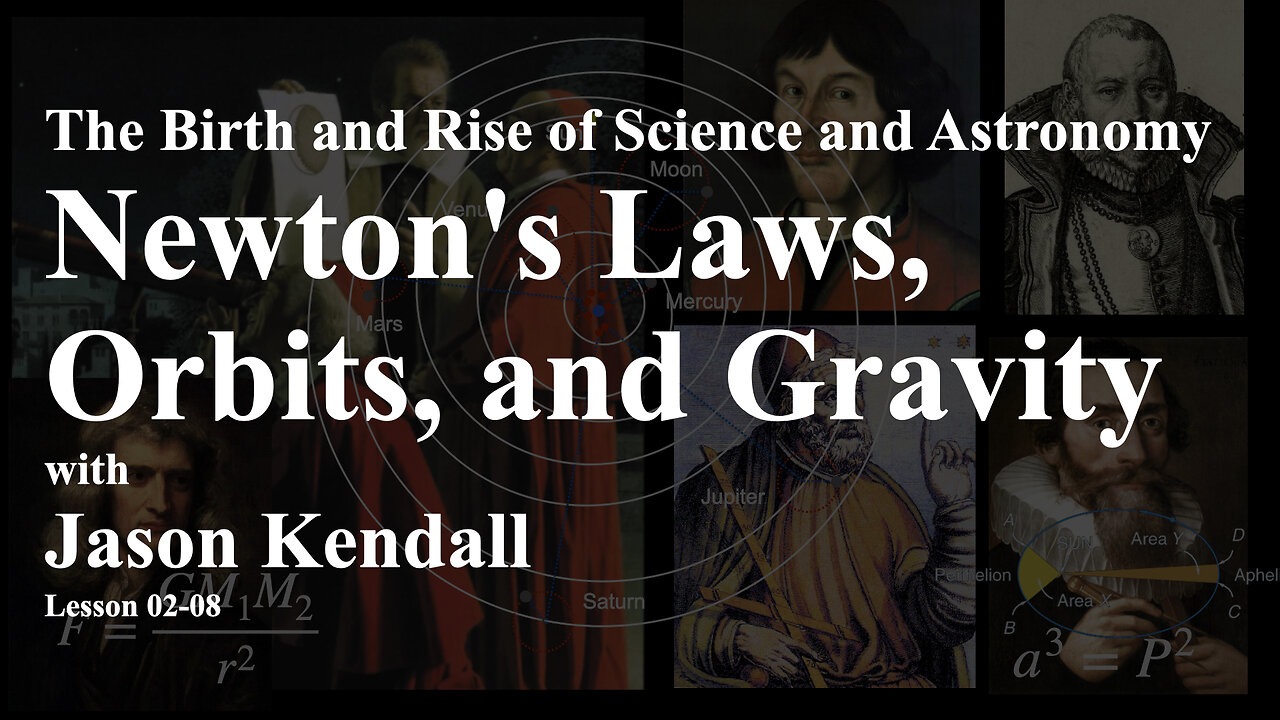Premium Only Content

Unraveling the Cosmos: Newton’s Laws and the Secrets of Celestial Motion
In the realm of astronomy, the evolution of scientific understanding has often been marked by pivotal figures and their groundbreaking contributions. This essay endeavors to elucidate the critical period that followed the works of Johannes Kepler and Galileo Galilei, leading to the eventual formulation of Newtonian physics, which provided a coherent framework for understanding celestial motion. This discourse will explore the interconnections among the scientific endeavors of figures such as Edmond Halley, Robert Hooke, and Sir Isaac Newton, emphasizing the significance of their contributions to the field.
The late 17th century was characterized by a fervent quest for knowledge regarding the mechanics of celestial bodies, particularly in the wake of Kepler’s laws of planetary motion. Although Kepler had laid foundational principles regarding the elliptical orbits of planets, the underlying forces governing these motions remained inadequately understood. The discourse surrounding these astronomical phenomena intensified, prompting rigorous exploration by various eminent scientists. In 1684, Halley, Hooke, and Wren engaged in a pivotal discussion in London, wherein Hooke posited the existence of an inverse square law governing planetary motion. However, despite his assertions, Hooke failed to provide empirical evidence or documentation to substantiate his claims, leaving a gap in the scientific discourse.
Halley’s persistent inquiries eventually led him to visit Newton at Cambridge, where he learned that Newton had independently arrived at similar conclusions regarding the laws of motion and gravitation. Newton’s reclusive nature and his reluctance to engage in public disputes, particularly with the more outspoken Hooke, contributed to a delay in the dissemination of his findings. Nevertheless, Halley encouraged Newton to formalize his theories, which culminated in the publication of the “Philosophiæ Naturalis Principia Mathematica” in 1687. This seminal work established Newton’s three laws of motion and the law of universal gravitation, fundamentally altering the trajectory of scientific inquiry.
Newton’s first law of motion articulates the principle of inertia, asserting that an object remains at rest or in uniform motion unless acted upon by an external force. This principle resonates with Galileo’s observations regarding the behavior of objects in motion, reinforcing the concept that the absence of net forces results in unchanged states of motion. The implications of this law extend to various phenomena, including the behavior of objects within a vessel, where they maintain their motion relative to the vessel’s motion unless influenced by external forces.
The second law of motion, articulated as F=ma, delineates the relationship between force, mass, and acceleration. It posits that the acceleration of an object is directly proportional to the net force acting upon it and inversely proportional to its mass. This principle elucidates the mechanics of acceleration, providing a comprehensive framework for understanding how forces induce changes in an object’s velocity. Newton’s third law states that for every action, there exists an equal and opposite reaction, highlighting the reciprocal nature of forces in interactions. This principle is foundational in understanding the dynamics of systems, including the gravitational interactions between celestial bodies.
Central to Newton’s contributions is the law of universal gravitation, which posits that every mass attracts every other mass with a force proportional to the product of their masses and inversely proportional to the square of the distance between their centers. This law not only explains terrestrial phenomena but also provides the mathematical foundation for celestial mechanics. The gravitational force acts as the central force governing the motion of planets around the sun, facilitating the derivation of Kepler’s laws from Newtonian principles.
Using calculus, which Newton developed to analyze rates of change, one can derive the elliptical orbits described by Kepler. The calculus enables the mathematical manipulation of the relationships between the forces acting upon celestial bodies, their masses, and their trajectories. This revolutionary approach to understanding motion marks a significant advancement in the scientific method, allowing for the prediction of planetary positions and the exploration of gravitational influences across vast distances.
The interplay of gravitational forces also extends to the concept of the center of mass, wherein two bodies orbit their common center of mass due to their mutual gravitational attraction. This principle is observable in the Earth-Moon system, where both bodies exert gravitational forces upon each other, resulting in their respective orbits around a shared center of mass. The implications of this understanding extend to binary star systems and other celestial configurations, illustrating the universality of Newton’s laws across diverse astronomical contexts.
In conclusion, the era following Kepler and Galileo was marked by significant advancements in the understanding of celestial mechanics, culminating in Newton’s revolutionary contributions. The synthesis of empirical observations and mathematical formulation paved the way for a comprehensive understanding of gravitational interactions and motion in the cosmos. Newton’s laws of motion and the law of universal gravitation remain foundational to modern physics, providing enduring insights into the behavior of celestial bodies and the intricate mechanics of the universe.
-
 LIVE
LIVE
SynthTrax & DJ Cheezus Livestreams
1 day agoFriday Night Synthwave 80s 90s Electronica and more DJ MIX Livestream 80s Night / Late Night Nostalgia
336 watching -
 4:05:52
4:05:52
Nerdrotic
7 hours ago $0.15 earnedHollywood REGRET | Disney's Predator | The Feminist Avengers - Friday Night Tights 379
36.9K12 -
 DVR
DVR
Mally_Mouse
4 days agoFriend Friday!! 🎉 - Let's Play! - MIMESIS
5.13K2 -
 41:20
41:20
MattMorseTV
3 hours ago $0.19 earned🔴Schumer just BACKSTABBED his OWN VOTERS. 🔴
18.9K39 -
 3:33:34
3:33:34
MissesMaam
4 hours ago*Spicy* Friend Friday with Mally_Mouse!! 💚✨
2.71K3 -
 57:44
57:44
Candace Show Podcast
4 hours agoBen Shapiro Is Crying Again. | Candace Ep 261
43.2K175 -
 LIVE
LIVE
megimu32
3 hours agoOFF THE SUBJECT: MEMESIS w/ MALLY MOUSE | MISSES MAAM | SAVAGEJAYGATSBY
54 watching -
 LIVE
LIVE
a12cat34dog
3 hours agoI AM FINALLY BACK | Dying Light: The Beast x PUBG | COLLABORATION EVENT {18+}
54 watching -
 LIVE
LIVE
John_Goetz
3 hours agoJohn Gets Playing - Clair Obscur Expedition 33
4 watching -
 1:03:44
1:03:44
BonginoReport
5 hours agoNew Yorkers Are Movin' Out - Nightly Scroll w/ Hayley Caronia (Ep.173) - 11/06/2025
123K69